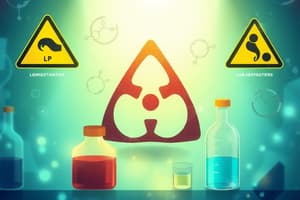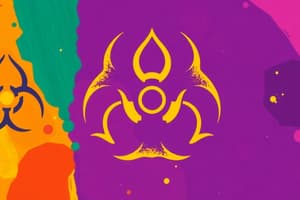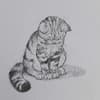Podcast
Questions and Answers
What is a 'mole' in chemistry?
What is a 'mole' in chemistry?
- A measure of volume
- A unit of mass
- A type of chemical bond
- A specific number of particles (correct)
What is the approximate value of Avogadro's constant?
What is the approximate value of Avogadro's constant?
- $9.8$
- $3.0 \times 10^{8}$
- $6.02 \times 10^{23}$ (correct)
- $1.66 \times 10^{-24}$
What information does the relative formula mass ($M_r$) of a compound provide?
What information does the relative formula mass ($M_r$) of a compound provide?
- The density of the compound
- The mass in grams of one mole of the compound (correct)
- The number of atoms in a single molecule
- The volume occupied by one mole of the compound
If the mass of a reaction vessel increases during a reaction, what is a likely cause?
If the mass of a reaction vessel increases during a reaction, what is a likely cause?
Which statement describes what happens to atoms during a chemical reaction, according to the law of conservation of mass?
Which statement describes what happens to atoms during a chemical reaction, according to the law of conservation of mass?
What is the primary characteristic of covalent bonds?
What is the primary characteristic of covalent bonds?
What type of structure do substances containing covalent bonds usually have?
What type of structure do substances containing covalent bonds usually have?
What happens to the strength of intermolecular forces as molecules get bigger?
What happens to the strength of intermolecular forces as molecules get bigger?
What is the arrangement of ions in ionic compounds?
What is the arrangement of ions in ionic compounds?
What happens to ionic compounds to allow them to carry an electric charge?
What happens to ionic compounds to allow them to carry an electric charge?
What is formed when a metal reacts with a non-metal?
What is formed when a metal reacts with a non-metal?
What type of ion is formed when an atom loses electrons?
What type of ion is formed when an atom loses electrons?
What charge is an ion that has more electrons than protons?
What charge is an ion that has more electrons than protons?
Ions are formed by elements in which groups?
Ions are formed by elements in which groups?
What is contained in the nucleus of an atom?
What is contained in the nucleus of an atom?
What is the charge of a neutron?
What is the charge of a neutron?
What number does the atomic number of an atom tell you?
What number does the atomic number of an atom tell you?
What does the 'Oxidising' hazard symbol indicate?
What does the 'Oxidising' hazard symbol indicate?
What type of harm can a 'Harmful' chemical cause?
What type of harm can a 'Harmful' chemical cause?
If a chemical is labelled as 'Corrosive', what hazard does it pose?
If a chemical is labelled as 'Corrosive', what hazard does it pose?
Flashcards
Oxidising Hazard
Oxidising Hazard
A hazard that provides oxygen which allows other materials to burn more fiercely.
Harmful Hazard
Harmful Hazard
A hazard that can cause irritation, reddening, or blistering of the skin.
Environmental Hazard
Environmental Hazard
A hazard that is harmful to organisms and the environment.
Highly Flammable Hazard
Highly Flammable Hazard
Signup and view all the flashcards
Toxic Hazard
Toxic Hazard
Signup and view all the flashcards
Corrosive Hazard
Corrosive Hazard
Signup and view all the flashcards
What is 'The Mole'?
What is 'The Mole'?
Signup and view all the flashcards
Avogadro's Constant
Avogadro's Constant
Signup and view all the flashcards
Relative Formula Mass (Mr)
Relative Formula Mass (Mr)
Signup and view all the flashcards
Empirical Formula
Empirical Formula
Signup and view all the flashcards
Components of an Atom
Components of an Atom
Signup and view all the flashcards
The Nucleus
The Nucleus
Signup and view all the flashcards
Atomic Number
Atomic Number
Signup and view all the flashcards
Mass Number
Mass Number
Signup and view all the flashcards
Ions
Ions
Signup and view all the flashcards
Ionic Compound Composition
Ionic Compound Composition
Signup and view all the flashcards
Ionic Bonding Electron Transfer
Ionic Bonding Electron Transfer
Signup and view all the flashcards
Covalent Bond
Covalent Bond
Signup and view all the flashcards
Covalent Substances Structure
Covalent Substances Structure
Signup and view all the flashcards
Polymers
Polymers
Signup and view all the flashcards
Study Notes
Hazards and Risks
- A hazard has the potential to cause harm or damage
- Risk is the probability of harm to someone or something exposed to the hazard
- Chemical containers have symbols to indicate dangers
- Understanding symbols helps use suitable safe-working procedures in the lab
Common Hazard Symbols
- Oxidising provides oxygen, allowing other materials to burn fiercely, liquid oxygen
- Harmful causes irritation, reddening, or blistering of the skin, bleach
- Environmental Hazard harms organisms and the environment, mercury
- Highly Flammable catches fire easily, petrol
- Toxic causes death by swallowing, breathing, or absorption, hydrogen cyanide
- Corrosive destroys materials, including living tissue such as eyes and skin, concentrated sulfuric acid
Experiment Risks and Hazards
- Chemistry experiments have risks from equipment and chemicals
- Identify hazards, assess risks with likelihood and severity, and reduce risks
- A student reacting sodium hydroxide and hydrochloric acid needs to identify and reduce risks
- Sodium hydroxide and hydrochloric acid are harmful at low concentrations and corrosive at high concentrations
- Corrosive substances blister the skin or cause reddening of the skin
- Use low concentrations, gloves, a lab coat, and goggles to reduce risks when handling chemicals
Risk Assessment
- Required to safely carry out experiments with dangerous chemicals
- Suggest appropriate safety measures when experimenting with two chemicals, one of which is highly flammable
Studying That Suits You
Use AI to generate personalized quizzes and flashcards to suit your learning preferences.





